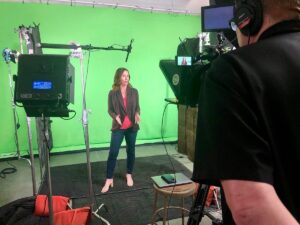 As a reporter and a morning show host for nearly two decades, I spent much of my career in front of a camera. There was so much I loved about the job – covering everything from federal murder cases to celebrity interviews to home and garden trends. Mostly, I loved telling stories that people could connect with.
As a reporter and a morning show host for nearly two decades, I spent much of my career in front of a camera. There was so much I loved about the job – covering everything from federal murder cases to celebrity interviews to home and garden trends. Mostly, I loved telling stories that people could connect with.
When I segued from being primarily on-camera to spending more time behind the microphone with voice acting, I still felt passionate about communicating powerful stories and messages. But, I wasn’t sure what to do with all the on-camera experience I had.
I found that people I had interviewed in the past, and even companies I had done business with had a unique need, and I had the skills. There is a place for people like me … with a combination of voice acting and video skills. Someone who can act as an on-camera spokesperson, a show or program host, or a product presenter, yet still provide narration as well.
There are certain genres of voiceover, including corporate training and narration, as well as eLearning, that rely on voice actors and video talent to bring some humanity to the otherwise boring computer training screen.
The more work I do, the more I realize that video experience is more translatable now than ever before. This is in part due to the pandemic, which only moved people more online. As so many jobs became remote, corporations, universities, hospitals, and other agencies had to discover new and engaging ways of training and informing employees.
The demand for eLearning and corporate training videos absolutely exploded during the pandemic. As people continue to become more resourceful and companies realize there are different ways to do things, there are more opportunities to provide video and voiceover services (even remotely).
As a voice actor and on-camera talent, I’ve had the chance to work on many corporate training and eLearning videos. When companies want to explain a concept that they don’t have visuals to illustrate, a spokesperson could help to share information in an easy-to-understand way.
During a recent shoot with Firestar Studios, my role was to introduce each eLearning module, breaking up long stretches of information with an on-camera delivery to connect with the audience, keep them engaged, and provide a segue to the next section. Through this process, my role was to help humanize modules by connecting with the audience and showing that there are “real people” behind the service.
When using on-camera talent, it’s important to make sure it comes across as enthusiastic, relatable, and articulate. A company may want to use its own employees to connect with its audience. This is a great idea IF the employee is comfortable on camera, natural, and capable of maintaining energy and diction throughout. If not, it’s worth hiring a professional.
The benefits of hiring a voice actor with on-camera experience are many but first and foremost, it’s a time saver for clients. Many on-camera hosts (like myself) can provide studio time and additional VO from their home studio, which make pick-ups, changes, and updates down the road, quick and easy!
In addition, I have the ability to be flexible. As a voice actor and video talent, I can be where the client needs me to be, whether it’s in the field or in the studio. Recently, I participated in a green screen shoot with a client on zoom, which saved the clients both travel and hassle.
As the number of remote jobs continues to rise and more people work online than ever, companies will continue to discover new and engaging ways of training and informing employees. It’s hard to fathom just how much time we spend online and streaming videos, but globally it’s in the billions of hours per year between platforms. This indicates that the demand for eLearning and corporate training videos will continue to be an integral way that people receive information.
Recent Comments